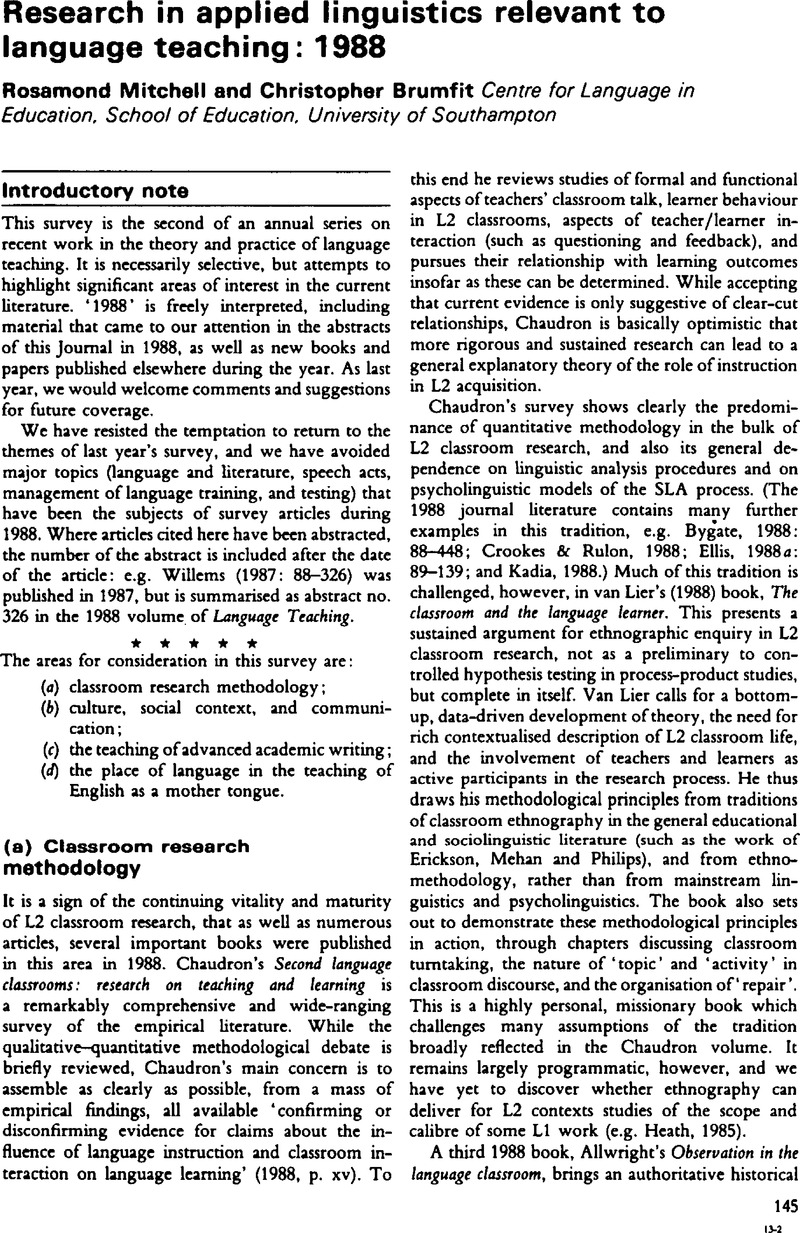No CrossRef data available.
Article contents
Research in applied linguistics relevant to language teaching: 1988
Published online by Cambridge University Press: 23 December 2008
Abstract
An abstract is not available for this content so a preview has been provided. Please use the Get access link above for information on how to access this content.

- Type
- Annual Review of Research
- Information
- Copyright
- Copyright © Cambridge University Press 1989
References
Allwright, J. (1988). Don't correct – reformulate! In Robinson, P. C. (ed.) (1988). 109–16.Google Scholar
Allwright, R. L. et al. (1988). Investigating reformulation as a practical strategy for the teaching of academic writing. Applied Linguistics, 9, 3, 236–56.CrossRefGoogle Scholar
Alptekin, C. (1988). Chinese formal schemata in ESL composition. British Journal of Language Teaching, 26, 2, 112–16.Google Scholar
Blanton, L. L. (1987). Reshaping ESL students' perceptions of writing. ELT Journal, 41, 2, 112–18.CrossRefGoogle Scholar
Bourne, J. (1988). “Natural acquisition” and a “masked pedagogy”. Applied Linguistics, 9, 1, 83–99.CrossRefGoogle Scholar
Britton, J. & Martin, N. (1988). English teaching – is it a profession? English in Education, 22, 2, 1–8.CrossRefGoogle Scholar
Bygate, M. (1988). Units of oral expression and language learning in small group interaction. Applied Linguistics, 9, 1, 59–82.CrossRefGoogle Scholar
Byram, M. (1988). Foreign language education and cultural studies. Language Culture and Curriculum, 1, 1, 15–31.CrossRefGoogle Scholar
Carter, R. (1988). Some pawns for Kingman: language education and English teaching. In P. Grunwell (ed.), 51–66.Google Scholar
Chaudron, C. (1988). Second language classrooms: research on teaching and learning. Cambridge: Cambridge University Press.CrossRefGoogle Scholar
Crookes, G. & Rulon, K. A. (1988). Topic and feedback in NS/NNS conversation. TESOL Quarterly, 22, 4, 675–81.CrossRefGoogle Scholar
Davies, N. F. & Omberg, M. (1987). Peer-group teaching and the composition class. System, 15, 3, 313–23.CrossRefGoogle Scholar
Department of Education and Science (1988). Report of the committee of inquiry into the teaching of English language (Kingman Inquiry). London: HMSO.Google Scholar
Dougill, P. & Knott, R. (1988). The primary language book. Milton Keynes: Open University Press.Google Scholar
Ellis, R. (1988 a). The effects of linguistic environment on the second language acquisition of grammatical rules. Applied Linguistics, 9, 3, 257–74.CrossRefGoogle Scholar
Ellis, R. (1988 b). Investigating language teaching: the case for an educational approach. System, 16, 1, 1–11.CrossRefGoogle Scholar
Franken, M. (1987). Self-questioning scales for improving academic writing. Guidelines (RELJ Journal Supplement), 9, 1, 1–8.Google Scholar
Gee, J. P. (1988). Dracula, the Vampire Lestat, and TESOL. TESOL Quarterly, 22, 2, 201–25.CrossRefGoogle Scholar
Graddol, D. & Swann, J. (1988). Trapping linguists: an analysis of linguists' responses to John Honey's pamphlet ‘The language trap’. Language ana Education, 2, 2, 95–111.CrossRefGoogle Scholar
Grunwell, P. (ed.) (1988). Applied linguistics in society, British Studies in Applied Linguistics 3. London: Centre for Information on Language Teaching and Research.Google Scholar
Hall, D. et al. (1986). Patterns of thought in scientific writing: a course of information structuring for engineering students. English for Specific Purposes, 5, 2, 147–60.CrossRefGoogle Scholar
Holec, H. (1988). L'acquisition de compétence culturelle. Quoi? Pourquoi? Comment? Etudes de linguistique Appliquée, 69, 101–10.Google Scholar
Holliday, A. (1988). Project work as an evaluation device. System, 16, 1, 77–86.CrossRefGoogle Scholar
Howell-Richardson, C. & Parkinson, B. (1988). Learner diaries: possibilities and pitfalls. In P. Grunwell, (ed.), 74–9.Google Scholar
Jacobs, G. (1988). Cooperative goal structure: a way to improve group activities. ELT Journal, 42, 2, 97–101.CrossRefGoogle Scholar
Kadia, K. (1988). The effects of formal instruction on monitored and on spontaneous naturalistic interlanguage performance. TESOL Quarterly, 22, 3, 509–15.CrossRefGoogle Scholar
Kennedy, G. D. (1987). Expressing temporal frequency in academic English. TESOL Quarterly, 21, 1, 69–86.CrossRefGoogle Scholar
Lynch, A. J. (1988). Speaking up or talking down: foreign learners' reactions to teacher talk. English Language Teaching Journal, 42, 2, 109–16.CrossRefGoogle Scholar
Medway, P. (1988). The students' world and die world of English. English in Education, 22, 2, 26–35.CrossRefGoogle Scholar
Michael, I. (1987). The teaching of English, from the sixteenth century to 1870. Cambridge: Cambridge University Press.CrossRefGoogle Scholar
Myers, G. (1988). The social construction of science and the teaching of English: an example of research. In P. C. Robinson (ed.) (1988). 143–50.Google Scholar
Rampton, M. B. H. (1988). A non-educational view of ESL in Britain. Journal of Multilingual and Multicultural Development, 9, 6, 503–29.CrossRefGoogle Scholar
Robinson, P. C. (ed.) (1988). Academic writing: process and product. ELT Documents, 129. Basingstoke: Modern English Publications.Google Scholar
Ross, S. (1988). Accommodation in interlanguage discourse from an EFL perspective. System, 16, 3, 347–54.CrossRefGoogle Scholar
Spack, R. (1988). Initiating ESL students into the academic discourse community: how far should we go? TESOL Quarterly, 22, 1, 29–51.CrossRefGoogle Scholar
Spada, N. M. (1987). Relationships between instructional differences and learning outcomes: a process-product study of communicative language teaching. Applied Linguistics, 8, 2, 137–61.CrossRefGoogle Scholar
Stubbs, M. W. (1988). Teachers, language study and linguistics: response to Westgate. English in Education, 22, 2, 61–4.CrossRefGoogle Scholar
Swales, J. (1987). Utilising the literatures in teaching the research paper. TESOL Quarterly, 21, 1, 41–68.CrossRefGoogle Scholar
Swales, J. & Najjar, H. (1987). The writing of research article introductions. Written Communication, 4, 2, 175–91.CrossRefGoogle Scholar
Taylor, D. S. (1988). The meaning and use of the term ‘competence’ in linguistics and applied linguistics. Applied Linguistics, 9, 2, 148–68.CrossRefGoogle Scholar
Tinkel, A. J. (1988). Explorations in language. Cambridge: Cambridge University Press.Google Scholar
Watson-Gegeo, K. A. (1988). Ethnography in ESL: defining die essentials. TESOL Quarterly, 22, 4, 575–92.CrossRefGoogle Scholar
Westgate, D. (1988). Westgate to Stubbs: over and out. English in Education, 22, 3, 76–78.CrossRefGoogle Scholar
Whitehead, F. (1988). ‘Quality’ revisited. English in Education, 22, 2, 54–60.CrossRefGoogle Scholar
Willems, G. M. (1987). Communication strategies and their significance in foreign language teaching. System, 15, 3, 351–64.CrossRefGoogle Scholar
Williams, J. (1988). Zero anaphora in second language acquisition: a comparison among three varieties of English. Studies in Second Language Acquisition, 10, 3, 339–70.CrossRefGoogle Scholar


